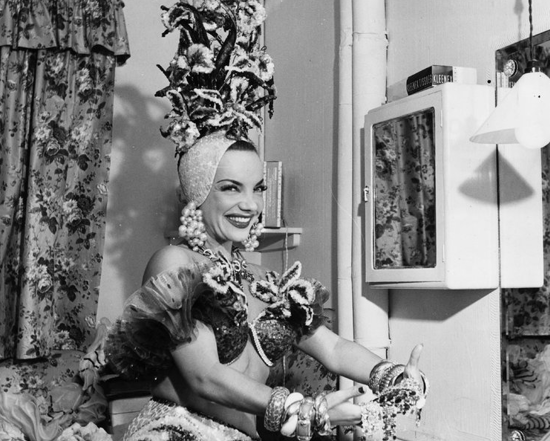Does the name Carmen Miranda sound familiar? What about “the lady in the tutti-frutti hat?” If not, do not feel ashamed, for many have forgotten the excellent Brazilian performer. No Brazilian artist, however, has achieved the international recognition that Carmen Miranda has, especially in Latin America and the States. She was one of the highest-paid women in Hollywood during the 1940’s.1 Yet she is today something of an unknown figure. Why is that?

Well, it dates back to the day she was born. Carmen Miranda was born Maria do Carmo Miranda da Cunha in a village in Portugal on February 9, 1909. She migrated to Brazil with her family in 1910, before turning two years old.2 Though she remained a Portuguese citizen, she was at home in Rio de Janeiro, Brazil. She began performing at a very early age, winning over her family and friends with her talent, and soon she had become a samba sensation. She was cutting records and was a star nearly a whole decade before coming to the United States. One night in 1939, while performing at the famous Cassino da Urca (in a neighborhood in Rio de Janeiro), New York producer Lee Shubert signed her for his show The Streets of Paris on Broadway, and away she went to take the world by surprise.3 While on Broadway, she enchanted everyone with her vibrant singing, dancing, and “Brazilian bombshell” beauty.
At 38 years old she married; however, given the huge persona she was, it is strange that there is not much known about her personal life. The extent of it is that she was raised Catholic, and this may be the reason she married at a mature age. It was rumored that she and her husband, David Sebastian, had a troubled marriage.
It was 1940 when she returned from Broadway to her homeland Brazil, but she was devastated by the way she was received. At the same Casino where Shubert had snatched her from less than a year earlier, Miranda performed to a crowd in awkward silence; only when she began to sing in English did the crowd make some noise, booing. She stopped the show and was so upset that she burst into tears. This incident sent her fleeing from the country, and for about fifteen years she did not return.4
Meanwhile, Miranda spent her time on Broadway and in Hollywood, Las Vegas, and London starring in movies, performing in casinos and clubs, expanding her fame and reputation. She was the tropical beauty from Brazil and there was no one to change her mind about it. Yes, she was a European woman with pale skin and green eyes, but these features are what made her unique, and people found it interesting that a woman like her sang black music. Her unique style gave her the recognition she has acquired as an iconic Latin American. Carmen Miranda was well-known for her outrageously colorful costumes, which called for high platform heels, lots of jewelry, flamboyant dresses, and most famously the turbans with fake fruit stacked so high that it added height to her short stature of 5’0’’. 5 “In Brazil in Bahia, the girls carry the basket with the fruits on her head, and they have big bracelets and big necklaces and they sell fruits in the streets and I take it [my style] from the girls,” Miranda explained as the source of her image.6

For years people have attacked Carmen Miranda on racial grounds. Critics say she had returned to Brazil americanizada. In response, she wrote a song in their mother tongue—the only country in Latin America to speak Portuguese—whose title translates to “They Say I Came Back Americanized.”7 It was also said that she was a sellout and was not truly a native, having been born in Portugal. Some say she was simply portraying the “Brazilian Bombshell” image and embodied the typical stereotype the U.S. public wanted to see in Brazilians, and Latin Americans more generally, where women are highly sexualized. Others argued that her style had created a distorted view of the country, as being sexually exposed, extravagantly colorful, and fruity. They argued that the turbans she wore were not even Brazilian customs and were only used to make fun of her.8 She was even mocked on a Bugs Bunny cartoon. To make matters worse, some said she had no right to sing samba, a music inherited in Brazilian black slums.

On the contrary, Carmen Miranda put Rio de Janeiro on the map of spectacular. She was the most successful person Brazil had produced. In a way, she served as an unofficial ambassador for her country, and it is heavily reflected in her movie roles.9 Everything that was Latin American was a hybrid presented in her performances, her style, her songs, friends and fans. She was everything, and nothing at once: Brazilian, Mexican, Argentinian, Cuban. Hollywood productions during this time period would touch on different cultures, but never fully embrace one, and this may have been what happened to Miranda. She became involved in Franklin D. Roosevelt’s Good Neighbor Policy, which was a program determined to improve relations with the nations of Central and South America.10 She still is the only South American to be immortalized in concrete at Sid Grauman’s Chinese Theatre, “To Sid, VIVA! in the South American Way. Carmen Miranda. March 24th 1941,” neighboring none other than Frank Sinatra. 11 Rio’s Museum of Modern Art welcomed Carmen Miranda with a major retrospective; “Carmen Miranda Forever,” where clips from her movies were shown, and gowns and turbans were showcased. She even had a museum in Rio dedicated to her, the Carmen Miranda Museum. Here, there was a wide variety of arrangements, gowns, costumes, shoes, and anything you can think of that she had performed in. The building itself was not lavish and fabulous as she was. Therefore it did not suit the gems hidden inside. Due to lack of maintenance and funds, it was closed down. It was agreed that Miranda deserved better.12 On the bright side, the museum is being relocated to Rio de Janeiro Museum of Image and Sound, expecting to open anytime soon. 13

It is a difficult task to relate to Carmen Miranda’s plight. She took many chances in leaving Brazil: that of being lost in translation, the crossing of geographical and cultural borders, sounding like herself in a different language, being in a sustained condition of exile. One person could not possibly represent an entire continent, especially one as diverse as that of Latin America with its many rich cultures. Today, it is not rare to be a Brazilian in the United States, in contrast to the way it once was. With that in mind, there is no Brazilian artist that has coped with these issues on the scale that Miranda had to in her prime. A director for a play on Carmen Miranda’s life said it better than anyone: “Carmen hasn’t been forgotten, but she’s been kind of ignored or neglected in recent years.”14 There are people today who have become interested in her, that have opened their minds to who she really was and why she has become an obsolete figure. They will learn that she was a charming, charismatic, comical, and extravagant person, a figure to inspire.15
- Larry Rohter, “Arts Abroad: The Real Carmen Miranda Under the Crown of Fruit,” New York Times, Dec. 13, 2001. Accessed April 13, 2017, http://www.nytimes.com/2001/12/13/theater/arts-abroad-the-real-carmen-miranda-under-the-crown-of-fruit.html. ↵
- Encyclopedia of Latin American History and Culture, 2008, s.v. “Miranda, Carmen (1909-1955),” by John Cohassey. ↵
- Larry Rohter, “Arts Abroad; The Real Carmen Miranda Under the Crown of Fruit,” New York Times, Dec. 13, 2001. Accessed April 13, 2017, http://www.nytimes.com/2001/12/13/theater/arts-abroad-the-real-carmen-miranda-under-the-crown-of-fruit.html. ↵
- Larry Rohter, “Arts Abroad; The Real Carmen Miranda Under the Crown of Fruit,” New York Times, Dec. 13, 2001. Accessed April 13, 2017, http://www.nytimes.com/2001/12/13/theater/arts-abroad-the-real-carmen-miranda-under-the-crown-of-fruit.html. ↵
- Maria Rubia Macedo, “Images of Latin America In the Body and Costumes of Carmen Miranda’s Stylized Baiana: Social Memory and Identity,” Comunicação e Sociedade 24, (2013): 186-209. ↵
- Lulu Garcia-Navarro, “Of Fruit Hats and ‘Happy Tropics,’ A Renaissance for Carmen Miranda,” NPR Parallels, April 22, 2015. Accessed April 13, 2017, http://www.npr.org/sections/parallels/2015/04/22/401467980/of-fruit-hats-and-happy-tropics-a-renaissance-for-carmen-miranda. ↵
- Lulu Garcia-Navarro, “Of Fruit Hats and ‘Happy Tropics,’ A Renaissance for Carmen Miranda,” NPR Parallels, April 22, 2015. Accessed April 13, 2017, http://www.npr.org/sections/parallels/2015/04/22/401467980/of-fruit-hats-and-happy-tropics-a-renaissance-for-carmen-miranda. ↵
- Larry Rohter, “Arts Abroad; The Real Carmen Miranda Under the Crown of Fruit,” New York Times, Dec. 13, 2001. Accessed April 13, 2017, http://www.nytimes.com/2001/12/13/theater/arts-abroad-the-real-carmen-miranda-under-the-crown-of-fruit.html. ↵
- Lulu Garcia-Navarro, “Of Fruit Hats and ‘Happy Tropics,’ A Renaissance for Carmen Miranda,” NPR Parallels, April 22, 2015. Accessed April 13, 2017, http://www.npr.org/sections/parallels/2015/04/22/401467980/of-fruit-hats-and-happy-tropics-a-renaissance-for-carmen-miranda. ↵
- “Good Neighbor Policy,” Office of the Historian, April 13, 2017, https://history.state.gov/milestones/1921-1936/good-neighbor. ↵
- Ralph Morris, “Carmen Miranda, Grauman’s Chinese Theater,” Los Angeles Public Library Photo Collection, Accessed April 13, 2017, https://calisphere.org/item/d381f8bd9fd414dd5661ab0aeeffa4a7/. ↵
- Mac Margnolis, “We Still Have Bananas,” Newsweek (Atlantic Edition) 147, no. 4 (January 23, 2006): 55. ↵
- Lulu Garcia-Navarro, “Of Fruit Hats and ‘Happy Tropics,’ A Renaissance for Carmen Miranda,” NPR Parallels. April 22, 2015. April 13, 2017. http://www.npr.org/sections/parallels/2015/04/22/401467980/of-fruit-hats-and-happy-tropics-a-renaissance-for-carmen-miranda. ↵
- Larry Rohter, “Arts Abroad; The Real Carmen Miranda Under the Crown of Fruit,” New York Times, Dec. 13, 2001. Accessed April 13, 2017, http://www.nytimes.com/2001/12/13/theater/arts-abroad-the-real-carmen-miranda-under-the-crown-of-fruit.html. ↵
- Film clip “Carmen Miranda: ‘Rebola a Bola’ (1941),” from Week-End in Havana, film directed by Walter Lang, 20th Century Fox, 1941. Music by Aloysio de Oliveira and Nestor Amaral, lyrics by Francisco Eugenio Brant Horta, sung in Portuguese by Carmen Miranda. ↵



83 comments
Justin Garcia
This is a very well developed article. I didn’t know anything about Carmen Miranda before reading this article. I can confidently say this gave me an appreciation for a great artist. It is very unfortunate that may people forgot about her. Knowing that being an minority in the field of art is difficult. I believe that those artists that came before modern day artists shouldn’t be forgotten.
Maria Callejas
Very creative title choice, the Portuguese calls for attention immediately. Awesome intro, it definitely served its purpose. I had no prior knowledge of who Carmen Miranda was, maybe I have seen pictures of her before. This is a great insight into her life, it is truly saddening to see how her fellow Brazilians were almost jealous of her foreign success. One should be proud of anyone who pays respects to their country through their talent. That is why Brazilians should be proud of what Carmen Miranda accomplished as an artist. Hopefully, people stop ignoring such gifted artist. Great job!
Tyler Bradford
I had never heard of Carmen Miranda, but after seeing her picture I realized who the article was actually talking about. I never knew that she was born in Portugal, but raised in Brazil. For the longest time I just assumed she was originally from Brazil or of some latin descent. It’s nice to know she had an amazing talent and didn’t let it go to waste. Overall, this was a great article.
Carlos Aparicio
As a young child, I do remember the “Lady with the tutti-fruity hat”. I never knew her name or what her purpose in life was until now. I love that the article explains how she came about from Portugal to representing how she became a Latin American figure. It’s amazing how she went from a little girl dancing in Brazil to performing in Hollywood, Las Vegas, and even London. It sad that her own country rejected her when she returned because she was “Americanizada”, or Americanized. She made a huge impact on Latin American and Brazilian culture with her style, songs, and beautiful characteristics. This was a very descriptive article.
Karla Chavana
Not forgotten but misremembered. I definitely remember the lady with the fruit basket on her head, although not sure where from. I think that Carmen Miranda tried to genuinely depict an image of the country which she loved and was raised in. However, I think all of her attempts and endeavors backfired when she found herself partaking roles that were not of her own adapted ethnicity. Regardless, it is nice to read an article bring back to light a superstar that has been presently absent.
Amber Aragon Alvarado
I honestly didn’t know who Carmen Miranda was until reading this article. After reading her story I was impressed with her talent and ambitions. She was born with talent and she made sure she used it. After traveling to different countries to perform she grew to be famous, but it did result in some setbacks when she returned to her hometown. Although it hurt her, it didn’t stop her from continuing to pursue her dreams. It’s inspiring how she didn’t slow down, but rather she continued to do what she loved doing. This article gave an awesome description of the life she lived considering the fact that I knew nothing of her. Very well written!
Veronica Spryszynski
As I was young I did know her as “the lady with the tutti-frutti hat”, I think I’ve heard her real name, Carmen Miranda, once before but grew to forget it. I won’t forget her story its amazing how much courage she had to go to a new country at a very young age. I do agree that she represents every country in the Latin American/Spanish region because her characteristics defines all of those and her singing was the start of her future. I don’t think it was right for her native country to criticized her and say she was “americanized” because she made the rest of the world recognize those latin countries and know their culture. Even though she was born in Portugal, since she moved to Brazil as 2 years old I can say she is also Brazilian because that is where she mainly grew up.
Aaiyanna Johnson
I was very happy to learn about Carmen Miranda. I had never known her name, now thankfully I do. I didn’t know that she was one of Hollywood’s highest paid women, but I know it was much earned. She is an inspiration to so many. I feel ashamed because I would always see women, sometimes men, dressed as her. I could never pin-point the origin. But thanks to this article I could never forget.
Christine Sackey
This article really helped to understand who Carmen Miranda was and what she dealt with in her life. I find it interesting that she was actually born in Portugal because I have always associated her with Brazil. It is inspiring to see all the monumental things that she was able to do even though she faced tremendous judgment for it. I enjoyed how you also spoke a little bit about the parts of her personal life that you could find. Overall, this was an interesting article.
Nahim Rancharan
First, I would like to mention that this article was Amazing! Not only that, but I enjoyed reading and discovering about one of the most iconic figures in American history. I enjoyed reading about Carmen Miranda’s multi-cultural history as well as how she effectively managed to portray a myriad of characters, mostly from those belonging to Latin American countries. Additionally, I liked how you highlighted her struggle in being accepted by her own people and what it took for her to become globally recognized. I also enjoyed how you managed to appropriately include different images that fit the article perfectly. I enjoyed seen her in her iconic fruit hat and her festive and elaborate costumes. Additionally, i l like how you included pictures showing her versatility like that of the cartoon. All of this tied to make a very interesting article. Great Job!